Related Research Articles

Hans-Adam II is the Prince of Liechtenstein. He is the son of Prince Franz Joseph II and his wife, Countess Georgina von Wilczek. He also bears the titles Duke of Troppau and Jägerndorf, and Count of Rietberg. Under his reign, a 2003 constitutional referendum expanded the powers of the Prince of Liechtenstein. In 2004, Hans-Adam transferred day-to-day governmental duties to his eldest son Hereditary Prince Alois as regent, like his father had granted him in 1984 to prepare him for the role.
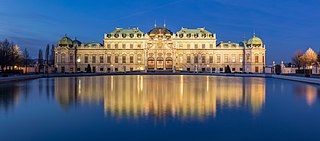
The Belvedere is a historic building complex in Vienna, Austria, consisting of two Baroque palaces, the Orangery, and the Palace Stables. The buildings are set in a Baroque park landscape in the third district of the city, on the south-eastern edge of its centre. It currently houses the Belvedere museum known in German as the Österreichische Galerie Belvedere. The grounds are set on a gentle gradient and include decorative tiered fountains and cascades, Baroque sculptures, and majestic wrought iron gates. The Baroque palace complex was built as a summer residence for Prince Eugene of Savoy.
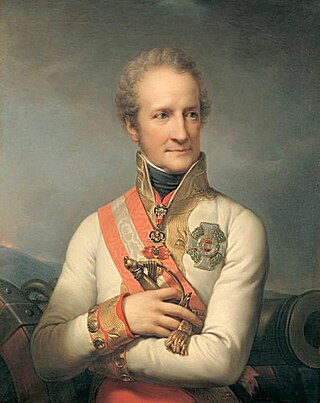
Johann I Joseph was Prince of Liechtenstein between 1805 and 1806 and again from 1814 until 1836. He was the last Liechtenstein prince to rule under the Holy Roman Empire between 1805 and 1806 and as regent of Liechtenstein from 1806 until 1814. He was the fourth son of Franz Joseph I, Prince of Liechtenstein.

Johann II, nicknamed the Good, was Prince of Liechtenstein from 12 November 1858 until his death in 1929.

Heinrich Laube, German dramatist, novelist and theatre-director, was born at Sprottau in Prussian Silesia.

Gebrüder Thonet or the Thonet Brothers was a European furniture manufacturer. Three firms descended from the original company remain active today, in Germany, Austria and the Czech Republic (TON).
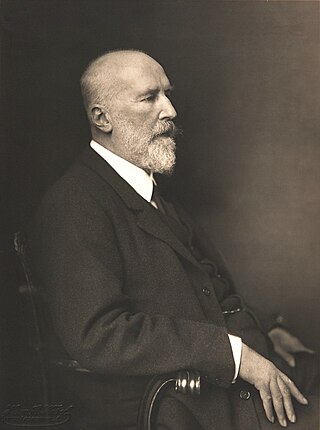
Franz I was Prince of Liechtenstein from 11 February 1929 until his death in 1938.

Baron Theophil Edvard von Hansen was a Danish architect who later became an Austrian citizen. He became particularly well known for his buildings and structures in Athens and Vienna, and is considered an outstanding representative of Neoclassicism and Historicism.

Prince Ferdinand Georg August of Saxe-Coburg and Gotha was a German prince of the House of Saxe-Coburg and Gotha and a general of cavalry in the Austrian Imperial and Royal Army during the Napoleonic Wars. Initially remaining a Lutheran until 1818, by marriage he established the Catholic branch of the family, which eventually gained the thrones of Portugal (1837) and Bulgaria (1887).

Franz Xaver Dieringer was a Catholic theologian. He was a professor of dogma and homiletics at the University of Bonn.

Michael Thonet was a German-Austrian cabinet maker, known for the invention of bentwood furniture.

Hugo Gerard Ströhl was an Austrian heraldist.

Prince Arnulf of Bavaria was a member of the Bavarian Royal House of Wittelsbach and a General of Infantry.

Carl Gangolf Kayser was an Austrian architect at the service of Emperor Maximilian I of Mexico, during the Second Mexican Empire. In the later part of his life he returned to Austria and worked on restoring medieval castles.
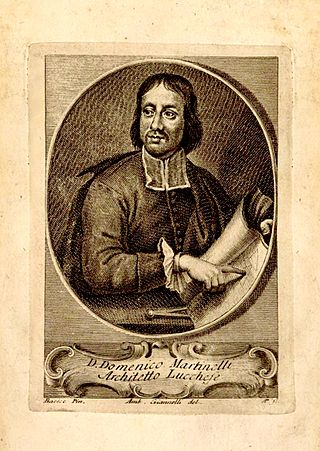
Domenico Martinelli was an Italian architect who worked for Carlo Fontana during 1678. He was an evident figure in the shaping of Baroque style in the North Alps. In 2010, a musical tribute called "Project Martinelli" was performed to him in Munich.
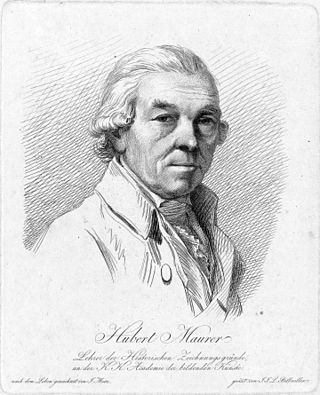
Hubert Maurer was a German painter, graphic artist and art professor.
Karl August Auberlen was a German Lutheran theologian.

Blasius Höfel was an Austrian copper engraver.

The Liechtenstein Palace is a neoclassical palace near Maria Enzersdorf in Lower Austria, bordering Vienna. It is on the edge of the Vienna Woods. It stands opposite south of Liechtenstein Castle, the ancestral seat of and place of origin of the House of Liechtenstein, the ruling family of the Principality of Liechtenstein. Prince Johann I of Liechtenstein (1760–1836) built the neoclassical palace in Biedermeier style at the start of the 19th century as one of the princely summer residences. In the aftermath of World War II, the palace fall into ruins and has been sold by the princely family.
Events in 1862 in animation.
References
- ↑ Colvin, Howard A Biographical Dictionary of British Architects, Omnigraphics Inc., London 1995.
- ↑ The "Catalogue of the Designs offered for the New Houses of Parliament now exhibiting in the National Gallery, 1836" includes a description of Desvignes' contest entry; House of Lords Record Office, London
- ↑ Huey, Michael Peter Hubert Desvignes und die Neo-Rokoko-Neugestaltung des Stadtpalais Liechtenstein 1837-1849, master's thesis, University of Vienna 1999.
- ↑ Huey, Michael Peter Hubert Desvignes und die Neo-Rokoko-Neugestaltung des Stadtpalais Liechtenstein 1837-1849, master's thesis, University of Vienna 1999.
- ↑ Witt-Dörring, Christian "Eine Art Offenbarung. Die Neugestaltung der Innenräume des Stadtpalastes Liechtenstein (1837-1848)" in Parnass, Sonderheft 11/95 (Die Sammlungen des Fürsten von Liechtenstein), Vienna 1995, pp. 72-78.
- ↑ Huey, Michael Peter Hubert Desvignes und die Neo-Rokoko-Neugestaltung des Stadtpalais Liechtenstein 1837-1849, master's thesis, University of Vienna 1999.
- ↑ Zone, Ray (February 3, 2014). Stereoscopic Cinema and the Origins of 3-D Film, 1838-1952. University Press of Kentucky. ISBN 978-0-8131-4589-1 – via Google Books.
- ↑ "Medals and Honourable Mentions Awarded by the International Juries: With a ..." Her Majesty's Commissioners. April 10, 1862. Archived from the original on July 24, 2020 – via Internet Archive.
- ↑ Hunt, Robert (1862). Handbook to the industrial department of the International exhibition, 1862.